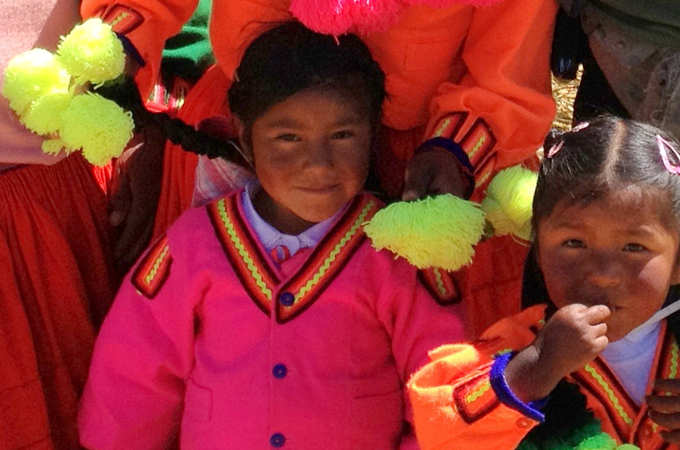Peru’s boat ride to better life
Children make perilous journeys daily to attend school on island in one of the world’s highest navigable lakes.

It doesn’t matter whether it rains or not.
Every morning, Amalia Suana puts on her best clothes and jumps on a small boat that her father lends her for a daily hour-long journey.
Keep reading
list of 4 items‘We share with rats’: Neglect, empty promises for S African hostel-dwellers
Thirty years waiting for a house: South Africa’s ‘backyard’ dwellers
Photos: Malnutrition threatens future Afghan generations
It’s the journey of her dreams. Since she was a child, she remembers, she wanted to go to school.
But living on a tiny island in Lake Titicaca and being so poor made it impossible for her parents to send her inland to class. So Amalia, now 26 years old, has become a teacher.
| Peru’s floating classroom |
“The idea surged from looking at the children and thinking that I didn’t have the opportunity to go to school as a child. The children have the right to be educated,” she says.
She paid her way through college selling handicrafts to hundreds of tourists. And then she thought the next step was to build a school. It was simple: wooden floors and corrugated iron boards for the wall and ceiling. She painted them yellow. This turned out to be the first kindergarten in the region.
There weren’t any in the whole area of the Uros islands in Lake Titicaca, one of the word’s highest navigable lakes.
So now, every morning the small motor boat has become the most-liked sound in the area. From island to island Amalia goes around picking up the children, who rush from their homes when they hear it coming. The mothers run behind them carrying tiny backpacks where they carry a book, a pencil, and sometimes a fruit.
These are among the poorest children in Peru. Some of the kids jump on board barefooted. “Send us shoes,” shouts one mom at a media crew. She is smiling, but she means it: they have no money to buy shoes.
And it’s quite cold here. Puno, where Lake Titicaca is, is known in Peru to have one of the highest rates of children who die from the cold. Sixteen children have perished from the freezing temperatures this year alone.
Dangerous journey
The daily journey is dangerous: the water is cold and many of the children, without lifevests, dont know how to swim.
|
“Finally they have a school, and I’m happy because they are learning the vowels and the alphabet and the numbers, and they also learn to play.” – Elsa Lujano, mother |
Amalia is concerned about the dangers. “We need lifevests and a bigger motor boat. With the sun and the rain it is always difficult for the children”, she says.
But the children are unaware of this. Five-year-old Antony feels secure travelling sitting on the very edge, as his feet float in the air. He smiles. Four-year-old Fresha says she will not fall because she’s holding on.
The parents also dismiss these dangers. The most important thing for them is to send their children to school.
Antony’s mother, Elsa Lujano, cannot contain her joy. “Finally they have a school, and I’m happy because they are learning the vowels and the alphabet and the numbers, and they also learn to play”.
Elsa Vilca hands over her three-year-old to Amalia. Rosmery is crying but her mother Elsa has a big smile on her face. “I want her to learn the letters,” she says as she waves goodbye and Amalia speeds up.
The trip frequently has problems. The motor breaks down. It happened that morning too. So, Amalia has to row. It could be two hours before they reach the school located on Amalia’s family island, called Tupiri Corazon.
But Amalia calls the children’s attention, and the little ones sing during the last leg of the trip.
As they near the school, tourists look at the boat and marvel. Amid the poverty, the parents have done their best in sewing up colorful uniforms with embroidered flowers and white pressed shirts.
The Uros islands are famous for their floating, man-made reed structures. And they are a huge tourist magnet.
Changing children
 |
| The children are able to learn largely with the help of donations [Mariana Sanchez/Al Jazeera] |
But Amalia, who likes visitors, has learned to dismiss promises of help. “Everyone comes here and sees the situation and promises to help. Then they leave and never come back. We have not even received government help.”
The children’s parents are too poor to help pay for the costs. The children are able to learn largely with the help of donations. People send in pencils, books, and games.
And with Amalia’s will and determination, the children are changing. “I can see how they are developing. Now these children talk, they ask questions, you can see the difference with those who don’t go to school. Those children are shy, and hide with their mothers. These kids are now becoming independent,” she says.
And now Amalia has yet another dream: to bring in more teachers and open up more schools. Few around the Uros doubt she will soon begin that new challenge.
Amalia spends hours teaching these little ones the alphabet, but she also plays with them for long hours.
Amalia gears up to begin the hour-long journey. It is time to bring the children back home. Hopefully the motor will not break down.